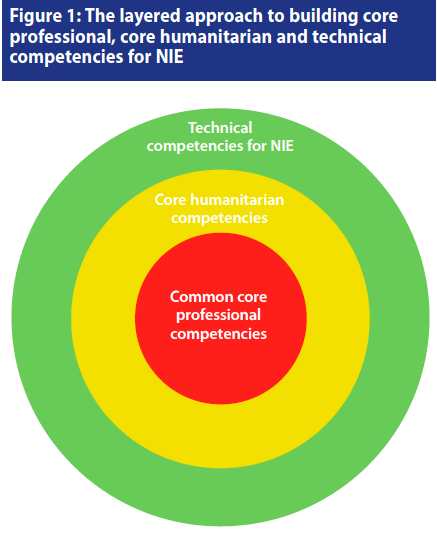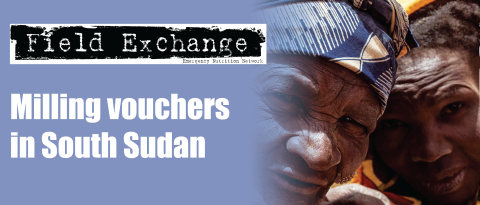Development of a competency framework for the nutrition in emergencies sector
Summary of published paper1
Location: Global
What we know: There has been increased investment in and attention to professional development of humanitarian staff. There are national and international capacity gaps in nutrition in emergencies (NIE). A NIE competency framework does not exist. Competency frameworks are used as a basis for recruitment, training, professional development and continuous learning in many sectors.
What this article adds: A technical competency framework for NIE is proposed, modelled on existing humanitarian frameworks. NIE competencies are categorised as core (professional and humanitarian) and technical (a behavioural indicator). The NIE framework contains twenty competency areas with 161 behavioural indicators categorised into three levels (reflecting seniority). The framework has been adopted for preliminary use by Concern Worldwide, World Vision, Valid International and International Medical Corps. While the majority of the technical skills are covered in NIE training courses, many general core competencies are neglected and thus limit effectiveness in the field.
A key aspect of the humanitarian reform process has involved developing capacity. The 2005 Humanitarian Response Review noted: “there are simply not enough people with the right experience available quickly”. In response, there has been increased investment in training and professional development for existing and future cadres of humanitarian staff. A recognised set of standards for humanitarian staff would arguably improve performance and promote quality and accountability. The result has been the development of a number of competency2 frameworks, which are increasingly being used to measure ability and to structure training.
Despite serious gaps in national and international capacity on nutrition, no technical competency framework has been developed to describe the skills required for emergency nutrition preparedness, response and recovery. The Nutrition in Emergencies Regional Training Initiative (NIERTN), which aims to provide sustainable, high-quality training in nutrition in emergencies (NIE), highlighted the need for a more detailed examination of the role of emergency nutritionists and the skills required. A recently published paper documents the process of developing a proposed technical competency framework for NIE and discusses some of the potential opportunities and challenges to its implementation as a tool to strengthen human resource capacity.
Key features
The key features of a competency framework were identified from the review of existing frameworks and, using these as a guide, the NIE competencies identified were categorised as either core or technical. Core professional competencies are regarded as those that are needed to function effectively in a work environment and include behaviours such as the ability to communicate and work effectively with others, while core humanitarian competencies include behaviours that are required for humanitarian work, such as the application of humanitarian principles. Competencies that already feature in the existing core humanitarian frameworks were removed to avoid replication. The competencies were then assigned to a technical domain and where necessary, re-formulated into a behavioural indicator. Expressing competencies in the form of behavioural indicators facilitates the use of a framework as a tool for assessing ability and performance. Each behavioural indicator was then allocated to one of three levels, corresponding to progressive seniority within the sector. This allocation was done using NIE job specifications for posts requiring varying levels of professional experience.
Process
The identification of NIE competencies was comprehensive and consisted of four stages. First, existing competency frameworks, course curricula and emergency nutrition job specifications were reviewed and relevant competencies extracted. Frameworks, courses and job specifications were included only if they featured an aspect of emergency nutrition. Second, semi-structured interviews were conducted with a convenience sample of ‘field experts’ working for humanitarian organisations. Third, participants from NIE courses held in Uganda, Thailand and Lebanon in 2010 and 2011 were contacted to identify which skills they felt were essential for their roles in emergency nutrition. Finally, the compiled list of competencies was reviewed by members of the Capacity Development Working Group of the Global Nutrition Cluster (GNC-CDWG) during the second half of 2011.
Framework structure
Six humanitarian competency frameworks were identified and reviewed which led to the proposed structure for the NIE framework shown in Table 1. A total of fifty-six NIE job specifications were identified with roles ranging from graduate entry level to those requiring over 10 years’ experience. Job titles included nutrition advisers, coordinators, programme managers and chiefs of health and nutrition. The hiring organisations consisted of international humanitarian non-governmental organisations (NGO) and United Nations (UN) agencies, with thirty-six and twenty job specifications, respectively.
| Table 1: Proposed structure for NIE competency framework | |||
|
Competency |
Level 1 behaviour |
Level 2 behaviour |
Level 3 behaviour |
| Descriptive name of competency domain |
Required for fieldlevel workers |
Required for team coordinators/ supervisors |
Required for country and international level technical staff |
The full competency framework contains twenty competency areas with 161 behavioural indicators categorised into three levels. The competencies identified as essential for any individual working within NIE are diverse, encompassing common core competencies, such as communication and teamwork; humanitarian competencies essential to all humanitarian workers, such as knowledge and application of humanitarian system and standards; and nutrition specific technical areas, such as identification of micronutrient deficiencies. This leads to a layered approach to building a competency framework, which is based on the Child Protection in Emergencies (CPIE) framework (Save the Children 2010) and shown in Figure 1.
The framework has since been adopted for preliminary use by Concern Worldwide, World Vision, Valid International and International Medical Corps.

Application
Across the sectors reviewed, competency frameworks are used as a basis for recruitment, development of training and for professional development and continuous learning; the medical sector is particularly well researched. Recognised benefits include the introduction of transparent standards and increased public accountability. There are recognised limitations to the approach, including an increased administrative burden and possibility of a focus on achieving acceptable minimum standards rather than the best that is possible. Despite these limitations, competency-based learning is now dominant at most stages of medical training in high-income countries.
Those with a lack of formal academic qualifications, such as a relevant BSc, MSc or professional training certificate, are not necessarily excluded in this process as the essence of a competency-based approach is that individuals are assessed on skills and attributes that may have been gained through experience or personal development.
The framework can also be used to standardise training courses, by relating the indicators to learning objectives. Competency-based training naturally leads on to competency-based assessment methods. In the medical sector, assessing technical and behavioural competencies through observation of simulated situations is a valid method. This approach facilitates the assessment of a person’s behaviours, such as decision-making capacity, in addition to technical competencies.
Staff can use the framework as a self-assessment tool, grading themselves for each competency and identifying areas which would benefit from further development. The competency areas in which they score lower, or areas which they would like to develop, can then be focused upon, with the behavioural indicators providing clear examples of what is required to attain each level.
When comparing the competencies identified in the framework, there is a clear difference between what was identified as essential from job specifications and interviews and what is currently being taught in the NIE academic and training courses. While the majority of the technical skills are covered, many general core competencies are sorely neglected and were noted as limiting effectiveness in the field.
Many of the required competencies are not specific to emergency nutrition but overlap with disaster preparedness, recovery and long-term development work, e.g. data collection and surveys is a competency area required by both emergency and non-emergency nutritionists. There is also strong overlap with other humanitarian sectors such as food security and logistics. While there is need to strengthen nutrition capacity in both development and emergency contexts and development nutritionists inevitably respond in chronic emergencies, a separate competency framework for NIE is warranted given the unique set of skills, knowledge and behaviour needed. In addition, the mechanisms by which staff are recruited, assessed and supported usually differ between the development and emergency sectors.
The move to a competency-based approach is a logical step to strengthen the NIE sector and build human resource capacity. However, it is essential that indicators for monitoring and evaluating the use of competency frameworks are defined in order to build an evidence base on their use not just within NIE, but within the humanitarian sector as a whole.
1Meeker. J et al (2013). Development of a competency frame work for the nutrition in emergencies sector. Public Health Nutrition: page 1 of 11 doi:10.1017/S1368980013002607
2Competencies are defined as the behaviours and technical attributes that individuals must have, or acquire, to perform effectively in a particular role.


